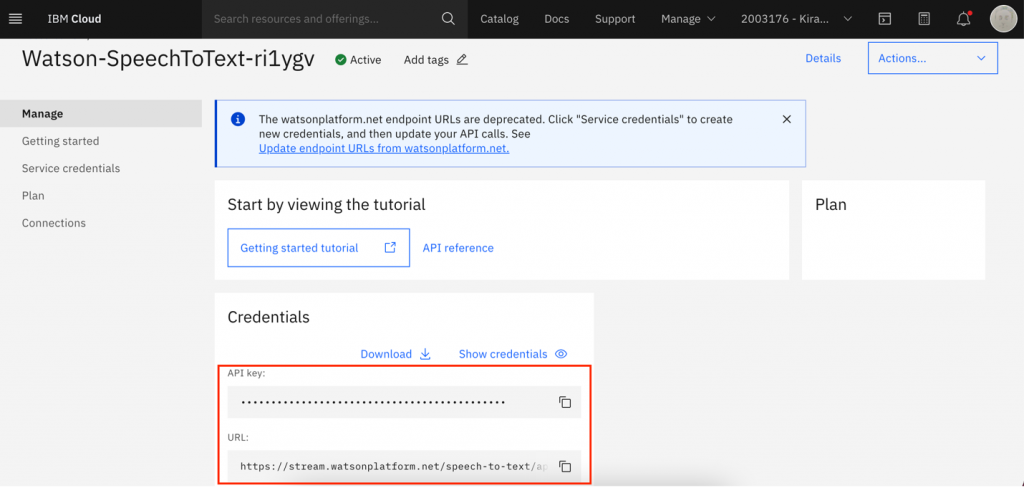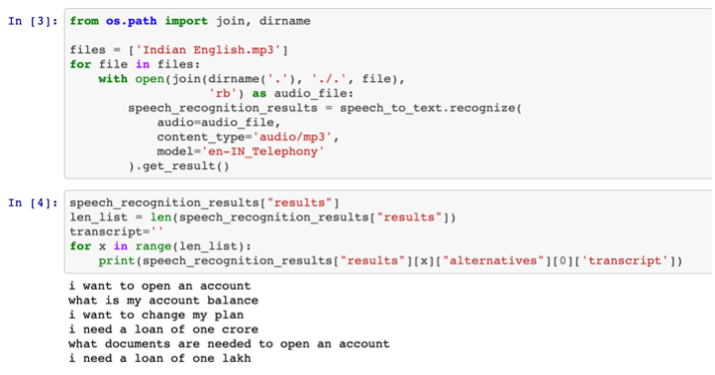.
Watson Speech to Text now supports Indian English and हिंदी!
August 26, 2021 | Written by: Kiran Challapalli
Categorized: . | Watson IoT
Share this post:
As the name suggests, “Speech to Text (STT)” is a mechanism by which machines convert speech or audio into text. STT is also known as Automatic Speech Recognition (ASR). The STT technology finds use in a wide variety of situations across industries.
For instance, it helps automate customer service in a call center where a caller’s speech is converted into text by the STT engine to identify the intent for the call, the entities referred to by the caller using specific nouns in the sentence, the caller’s emotion, and sentiment, among others. This information then helps formulate the best possible response. Another widely used scenario is the transcription of audio files to analyze trends and patterns based on public information about a brand or product. The former use case deals with live transcription, while the latter deals with batch transcription.
IBM Watson is a pioneer in the artificial intelligence (AI), natural language processing (NLP), and speech technology areas with a list of clientele that includes several large enterprises. To cater to Indian audiences, Watson Speech to Text technology is now trained to transcribe Indian English and Hindi language audios! These new services have been built using the next-generation models that offer very high throughput and much greater transcription accuracy.
How to access IBM Watson Speech to Text
You can try the new language features for free on IBM Cloud by using your existing IBM Cloud id to login or by creating a free account. To access the new feature, you have to first add the Watson Speech to Text service in your IBM Cloud account. The “Lite” plan allows you to use the service for up to 500 minutes in a month at no cost.

Tips for testing the new transcription service
Once you have created the service, try the transcription service using the Watson Speech to Text REST API interface. The IBM Cloud API docs is an excellent reference document that provides details of the API call as well as provides sample code to help you test in minutes. Watson supports several languages through various software development kits (SDKs), out of which I use the Python SDK. Check out my basic template: Jupyter Notebook (Test Indian English & Hindi models-Template.ipynb).


You can also leverage Postman using the following steps:
- Make a POST call with URL appended with “/v1/recognize”
- Use “Basic” authentication with Username as “apikey” and Password as the api key value.
- In “Params”, add “model” as “hi-IN_Telephony” or “en-IN_Telephony” depending on language of the audio file being transcribed
- Add header: “Content-Type” as “audio/xxx” (where xxx is audio format and can be mp3, etc.)
- In the Body, select “binary” and add the audio file to be transcribed

If you have a particular requirement related to speech transcription or would like to understand more about the technology, reach out to me for a free consultation. Click here to schedule.
Find out more on the IBM Watson webpage.
Insurance Company Brings Predictability into Sales Processes with AI
Generally speaking, sales drives everything else in the business – so, it's a no-brainer that the ability to accurately predict sales is very important for any business. It helps companies better predict and plan for demand throughout the year and enables executives to make wiser business decisions.
Never miss an incident with an application-centric AIOps platform
Applications are bound to face occasional outages and performance issues, making the job of IT Ops all the more critical. Here is where AIOps simplifies the resolution of issues, even proactively, before it leads to a loss in revenue or customers.
How ICICI Prudential Life Insurance is Scaling Customer Care and Leveraging AI to Personalize Experiences
Organisations are constantly challenged to meet dynamic customer requirements and rethink ways to engage with them on their terms and as per their convenience. With customers at the core of decision making and business success, organisations are tuning to digital capabilities that can support new-age services. When done well, after sales service boosts the overall customer experience by providing […]



